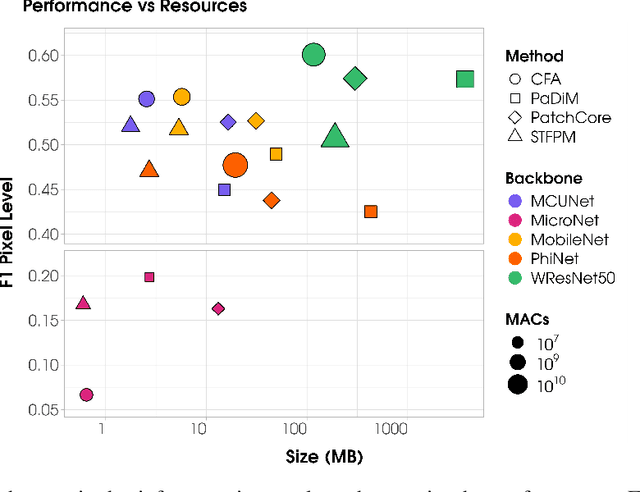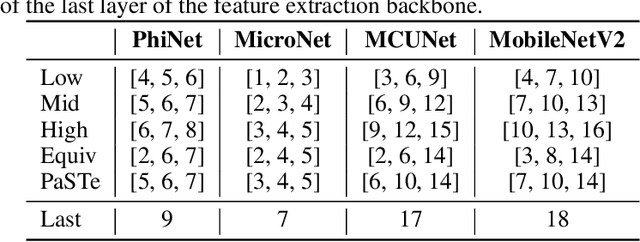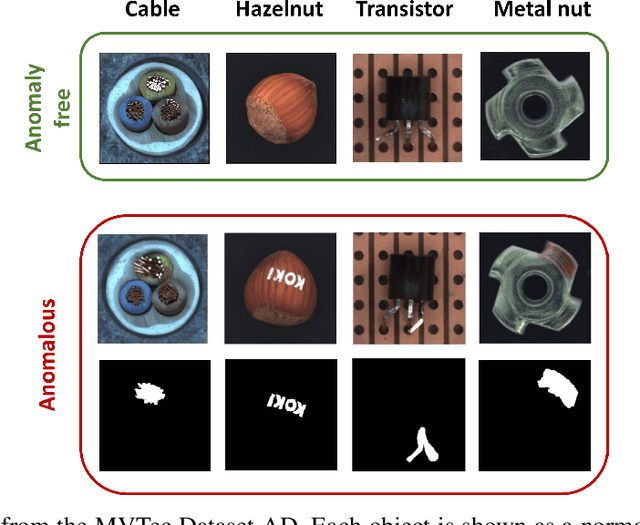Francesco Borsatti
Memory Efficient Continual Learning for Edge-Based Visual Anomaly Detection
Mar 04, 2025Abstract:Visual Anomaly Detection (VAD) is a critical task in computer vision with numerous real-world applications. However, deploying these models on edge devices presents significant challenges, such as constrained computational and memory resources. Additionally, dynamic data distributions in real-world settings necessitate continuous model adaptation, further complicating deployment under limited resources. To address these challenges, we present a novel investigation into the problem of Continual Learning for Visual Anomaly Detection (CLAD) on edge devices. We evaluate the STFPM approach, given its low memory footprint on edge devices, which demonstrates good performance when combined with the Replay approach. Furthermore, we propose to study the behavior of a recently proposed approach, PaSTe, specifically designed for the edge but not yet explored in the Continual Learning context. Our results show that PaSTe is not only a lighter version of STPFM, but it also achieves superior anomaly detection performance, improving the f1 pixel performance by 10% with the Replay technique. In particular, the structure of PaSTe allows us to test it using a series of Compressed Replay techniques, reducing memory overhead by a maximum of 91.5% compared to the traditional Replay for STFPM. Our study proves the feasibility of deploying VAD models that adapt and learn incrementally on CLAD scenarios on resource-constrained edge devices.
From Vision to Sound: Advancing Audio Anomaly Detection with Vision-Based Algorithms
Feb 25, 2025Abstract:Recent advances in Visual Anomaly Detection (VAD) have introduced sophisticated algorithms leveraging embeddings generated by pre-trained feature extractors. Inspired by these developments, we investigate the adaptation of such algorithms to the audio domain to address the problem of Audio Anomaly Detection (AAD). Unlike most existing AAD methods, which primarily classify anomalous samples, our approach introduces fine-grained temporal-frequency localization of anomalies within the spectrogram, significantly improving explainability. This capability enables a more precise understanding of where and when anomalies occur, making the results more actionable for end users. We evaluate our approach on industrial and environmental benchmarks, demonstrating the effectiveness of VAD techniques in detecting anomalies in audio signals. Moreover, they improve explainability by enabling localized anomaly identification, making audio anomaly detection systems more interpretable and practical.
PaSTe: Improving the Efficiency of Visual Anomaly Detection at the Edge
Oct 15, 2024



Abstract:Visual Anomaly Detection (VAD) has gained significant research attention for its ability to identify anomalous images and pinpoint the specific areas responsible for the anomaly. A key advantage of VAD is its unsupervised nature, which eliminates the need for costly and time-consuming labeled data collection. However, despite its potential for real-world applications, the literature has given limited focus to resource-efficient VAD, particularly for deployment on edge devices. This work addresses this gap by leveraging lightweight neural networks to reduce memory and computation requirements, enabling VAD deployment on resource-constrained edge devices. We benchmark the major VAD algorithms within this framework and demonstrate the feasibility of edge-based VAD using the well-known MVTec dataset. Furthermore, we introduce a novel algorithm, Partially Shared Teacher-student (PaSTe), designed to address the high resource demands of the existing Student Teacher Feature Pyramid Matching (STFPM) approach. Our results show that PaSTe decreases the inference time by 25%, while reducing the training time by 33% and peak RAM usage during training by 76%. These improvements make the VAD process significantly more efficient, laying a solid foundation for real-world deployment on edge devices.
Interpretable Data-driven Anomaly Detection in Industrial Processes with ExIFFI
May 02, 2024Abstract:Anomaly detection (AD) is a crucial process often required in industrial settings. Anomalies can signal underlying issues within a system, prompting further investigation. Industrial processes aim to streamline operations as much as possible, encompassing the production of the final product, making AD an essential mean to reach this goal.Conventional anomaly detection methodologies typically classify observations as either normal or anomalous without providing insight into the reasons behind these classifications.Consequently, in light of the emergence of Industry 5.0, a more desirable approach involves providing interpretable outcomes, enabling users to understand the rationale behind the results.This paper presents the first industrial application of ExIFFI, a recently developed approach focused on the production of fast and efficient explanations for the Extended Isolation Forest (EIF) Anomaly detection method. ExIFFI is tested on two publicly available industrial datasets demonstrating superior effectiveness in explanations and computational efficiency with the respect to other state-of-the-art explainable AD models.
 Add to Chrome
Add to Chrome Add to Firefox
Add to Firefox Add to Edge
Add to Edge